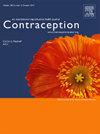Experience of nulliparous patients aged <30 years seeking permanent female contraception: A qualitative study
IF 2.3
2区 医学
Q1 OBSTETRICS & GYNECOLOGY
引用次数: 0
Abstract
Objective
This study aimed to describe the experience of nulliparous individuals aged <30 years when seeking permanent female contraception.
Study design
We recruited nulliparous individuals aged <30 years who underwent permanent female contraception in the United States in the last 2 years through a clinical Listserv, Facebook, and Reddit to participate in semistructured in-depth interviews. We summarized themes using the socioecological model.
Results
Thirty individuals from 20 states participated. The average age was 25 years (range 21–30). Most participants identified as White (25, 83%), non-Latine (28, 93%), had attended some college (27, 90%), and used online resources to seek permanent female contraception (22, 73%). On an individual level, childfree identity and the experience of trying other contraception methods led participants to choose permanent female contraception. On an interpersonal level, participants reported others’ support of bodily autonomy and childfree identity as facilitators and questioning permanent female contraception decisions as a barrier. On an institutional level, insurance coverage created confusion and stress. At the community level, social media interactions provided information and support. At the public policy level, the Dobbs decision increased the urgency to seek permanent female contraception.
Conclusions
This qualitative study of young, nulliparous individuals focuses on characterizing patients’ lived experiences and motivations for seeking permanent female contraception. Key findings included support stemming from a clinician’s acceptance of childfree identity, stressors from insurance coverage, benefits of using online resources, and the impact of the Dobbs decision on the urgency to seek permanent female contraception due to perceived threats to reproductive autonomy.
Implications
This study provides insights into the perspectives of young, nulliparous people who underwent permanent female contraception. Clinicians’ acceptance of childfree-identity and online resources are facilitators, and the Dobbs decision impacted urgency of seeking surgery. Findings should be integrated into policy and practice for improved person-centered care in a post-Dobbs society.
30岁以下未生育患者寻求永久性女性避孕的经验:一项定性研究。
目的:描述30岁以下未生育个体寻求永久性女性避孕的经验。研究设计:我们通过临床列表服务、Facebook和Reddit招募了30岁以下、在过去两年内在美国接受过永久性女性避孕的未生育个体,参与半结构化的深度访谈。我们使用社会生态模型(SEM)总结主题。结果:来自20个州的30人参与了调查。平均年龄25岁(21-30岁)。大多数参与者被确定为白人(25.83%),非拉丁裔(28.93%),上过大学(27.90%),并使用在线资源寻求永久性女性避孕(22.73%)。在个人层面上,没有孩子的身份和尝试其他避孕方法的经历导致参与者选择永久性女性避孕措施。在人际关系层面上,参与者报告说,其他人支持身体自主权和无子女身份,并质疑永久性女性避孕决定是一种障碍。在制度层面上,保险带来了混乱和压力。在社区层面,社交媒体互动提供了信息和支持。在公共政策层面,多布斯案的决定增加了寻求永久性女性避孕措施的紧迫性。结论:这一定性研究的年轻,未婚个体的重点是表征患者的生活经历和动机寻求永久女性避孕。主要发现包括临床医生接受无子女身份的支持,保险覆盖的压力源,使用在线资源的好处,以及多布斯决定对寻求永久性女性避孕措施的紧迫性的影响,因为生殖自主权受到威胁。含义:这项研究提供了对年轻,未生育的人谁接受了永久女性避孕的观点的见解。临床医生对无子女身份和在线资源的接受是促进因素,多布斯的决定影响了寻求手术的紧迫性。研究结果应纳入政策和实践,以改善后多布斯社会中以人为本的护理。
本文章由计算机程序翻译,如有差异,请以英文原文为准。
求助全文
约1分钟内获得全文
求助全文
来源期刊

Contraception
医学-妇产科学
CiteScore
4.70
自引率
17.20%
发文量
211
审稿时长
69 days
期刊介绍:
Contraception has an open access mirror journal Contraception: X, sharing the same aims and scope, editorial team, submission system and rigorous peer review.
The journal Contraception wishes to advance reproductive health through the rapid publication of the best and most interesting new scholarship regarding contraception and related fields such as abortion. The journal welcomes manuscripts from investigators working in the laboratory, clinical and social sciences, as well as public health and health professions education.
 求助内容:
求助内容: 应助结果提醒方式:
应助结果提醒方式:


